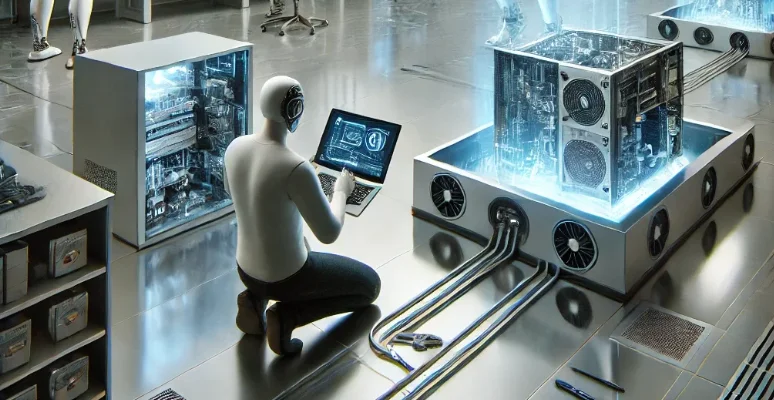In recent years, the rise of artificial intelligence (AI) in the tech support industry has significantly transformed the landscape of computer repair services. AI-driven solutions are becoming more prevalent, offering users an array of automated troubleshooting, diagnostics, and even repair capabilities. As AI tools evolve, they provide faster, more efficient services, sometimes bypassing traditional human intervention. We will explore how these advancements are reshaping the traditional computer repair industry, focusing on the challenges technicians face, consumer benefits, and the long-term implications for West Palm Beach businesses in this sector.
The Role of AI in Tech Support
Artificial intelligence has drastically altered the way computer problems are diagnosed and addressed. One of the most significant innovations has been the development of AI-based chatbots and virtual assistants that can instantly interact with users, diagnosing issues through pre-programmed algorithms. These systems often use natural language processing (NLP) to communicate with customers, simplifying the process of identifying and resolving technical problems. This AI-driven approach allows immediate assistance without requiring customers to wait for human agents, creating a seamless experience for users with common issues. However, while AI tools excel at handling routine or simple tasks, more complex issues may still require human intervention, highlighting a potential gap in the capabilities of automated systems.
Efficiency and Speed of AI Solutions
AI’s role in improving the efficiency and speed of tech support cannot be understated. In a traditional computer repair environment, users often experience long wait times for assistance, as technicians must manually diagnose and resolve issues. AI-driven solutions eliminate these delays, providing near-instantaneous responses and fixes for common problems. For example, AI-powered systems can run diagnostics, identify faulty software or hardware components, and suggest quick fixes within moments of a user reporting an issue. The speed of AI is beneficial for both consumers and businesses, allowing tech support companies to serve more clients in a shorter period. This shift towards rapid, automated responses is causing traditional computer repair shops to reconsider their methods of operation, as they now face the challenge of offering the same level of efficiency and convenience that AI provides.
Impact on Traditional Computer Repair Businesses
The rise of AI has forced traditional computer repair businesses to adapt or risk becoming obsolete. As AI-based solutions become more sophisticated, many consumers now opt for quick fixes offered through automated services rather than scheduling appointments with a technician. This shift is especially evident in the growing preference for self-service options, where users can troubleshoot and resolve minor issues using AI-driven platforms. For traditional repair shops, this presents a challenge: how can they compete with the convenience and accessibility offered by AI tools? One response from businesses has been integrating AI into their existing operations, enhancing their service offerings while retaining the personal touch that some customers still prefer. Repair shops may also focus on more complex services, which AI tools cannot manage effectively, allowing technicians to play a critical role in certain situations.
Changing Skill Sets and Workforce Dynamics
With AI taking over many of the routine tasks previously handled by technicians, the skill sets required in the computer repair industry are evolving. Technicians who once focused on physical hardware repairs and basic software troubleshooting must now adapt to a world where they must understand AI systems, their limitations, and how to integrate them into traditional service models. Repair businesses may now seek individuals skilled in traditional IT and AI technologies, creating a hybrid workforce that can handle a wider range of issues. This change in workforce dynamics is both an opportunity and a challenge: businesses can expand their offerings by leveraging AI while also training their workforce to work alongside emerging technologies. However, the increasing reliance on AI also raises concerns about job displacement, with some traditional roles in computer repair at risk of being automated.
Consumer Expectations and Experience
The growing use of AI in tech support has significantly altered consumer expectations regarding tech services. As more users experience the convenience and speed of AI-driven platforms, they are beginning to expect instant solutions to problems, particularly for common or simple issues. This shift in expectations puts pressure on traditional repair services to keep pace with AI’s technological advancements. Consumers now desire more seamless, user-friendly experiences, often including troubleshooting and repairing their devices without contacting a human technician. This trend has prompted traditional computer repair shops to reconsider their service models, focusing on offering value-added services that AI tools cannot replicate, such as personalized guidance, customer care, and specialized repair services for complex issues.
The rise of AI in tech support is undeniably changing the traditional computer repair industry, offering both challenges and opportunities. While AI has revolutionized the speed and efficiency of tech support services, traditional repair shops are forced to adapt to new expectations and technologies. By integrating AI into their operations and focusing on complex services that require human involvement, repair businesses can remain competitive in this rapidly evolving landscape. As the relationship between AI and human technicians continues to evolve, the industry’s future will likely be a balance between the convenience of automation and the nuanced understanding that only humans can provide. Ultimately, the success of traditional computer repair businesses will depend on their ability to embrace innovation while staying true to the personal service that has defined the industry for so long.

Shannon Reyes is a seasoned writer with a knack for crafting engaging blogs on a variety of service industries, including plumbing, cleansing, moving, pest control, and roofing. With a keen eye for detail and a passion for helping readers navigate complex topics, Shannon brings her expertise to life through informative and accessible content.










